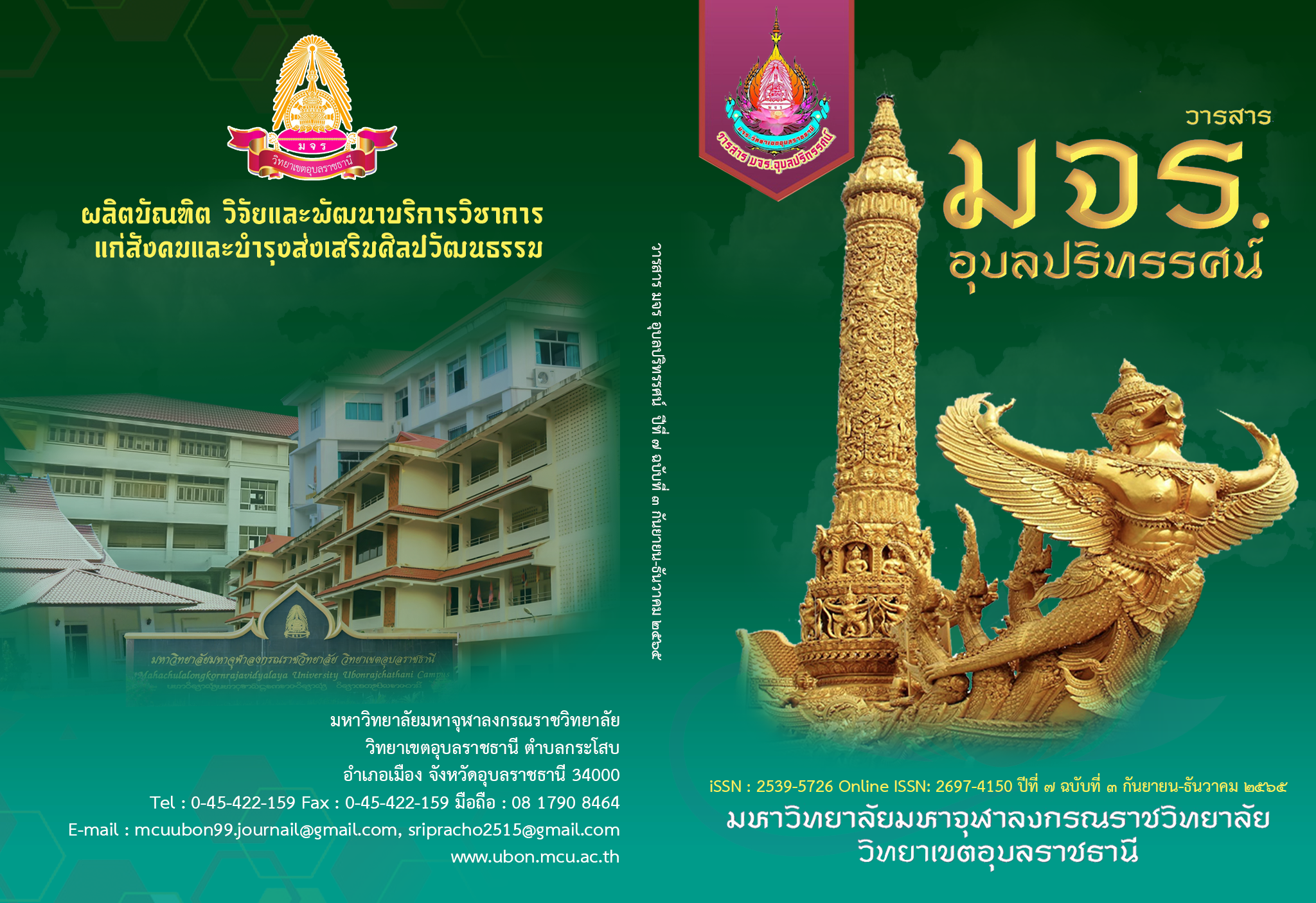LIVELIHOOD PROMOTION IN VILLAGES AS A MODEL OF FIVE-PRECEPT OBSERVATION: A CASE STUDY OF BAN SOMBOON COMMUNITY IN RUNG SUBDISTRICT, KANTHARALAK DISTRICT, SISAKET PROVINCE
Main Article Content
Abstract
The research subject " Livelihood Promotion in Villages as A Model of Five- Precept Observation: A Case Study of Ban Somboon Community in Rung Subdistrict, Kantharalak District, Sisaket Province aimed: 1) to examine the livelihood principles in Buddhist scriptures 2) to examine the livelihood promotion in villages as a model of five-precept observation: A case study of Ban Somboon Community in Rung Subdistrict, Kantharalake District, Sisaket Province. The findings showed that the way in applying the dharmic principles of Buddhism as the livelihood to become the foundation for occupation not to make people in community self-inflicted, and spoil societies directly and indirectly : abstaining from corrupting with body speech and mind by performing in the frame of morality, not falling for the power of defilements causing troubles for oneself and others because precepts are denial practices to control physical and verbal behaviors to be modest, which will be the foundation for morality development in higher levels of livelihood promotion. A case study in Ban Somboon Community in Rung Subdistrict, Kantharalak District, Sisaket Province as its model can be classified into 3 levels: 1) A model at a beginning level which can organize the utilizing activities in self-reliance to reduce poverty that is characterized as “Having enough to live and eat” for the household can live sufficiently 2) A model at a level “Living well, Eating well. Villages are ready to be a model for work expansion of which relations are connected with villages 3) A model at the level of “Wealthy, Comfortableness” is characterized to use knowledge in management with strengths to solve problems and develop in welfare arrangements for people in villages or community much extensively.
Article Details
References
พระพรหมคุณาภรณ์ (ป.อ.ปยุตฺโต). (2545). พุทธธรรม ฉบับปรับปรุงขยายความ. พิมพ์ครั้งที่ 20. กรุงเทพฯ: โรงพิมพ์ บริษัท สหธรรมิก จำกัด.
. (2549). พุทธธรรม. พิมพ์ครั้งที่ 11. กรุงเทพฯ: โรงพิมพ์ บริษัท สหธรรมิก จำกัด.
พระชวลิต จิรวฑฺฒโน (ยั่งยืน). (2561). “กระบวนการส่งเสริมการรักษาศีล 5 เพื่อพัฒนาคุณภาพชีวิตของประชาชน ในตำบลแม่ต๋ำ อำเภอพญาเม็งราย จังหวัดเชียงราย”. บัณฑิตวิทยาลัย: มหาวิทยาลัยมหาจุฬาลงกรณราชวิทยาลัย.
พระธานี เขมธมฺโม (จำปา). (2550). “ศึกษาสัมมาอาชีวะในพระพุทธศาสนา”. บัณฑิตวิทยาลัย: มหาวิทยาลัย มหาจุฬาลงกรณราชวิทยาลัย.
วิมลพรรณ หาญชนะ. (2561). “แนวทางการส่งเสริมการรักษาศีล 5 : กรณีศึกษาของนักศึกษามหาวิทยาลัยราชภัฏรำไพพรรณี”. บัณฑิตวิทยาลัย: มหาวิทยาลัยมหาจุฬาลงกรณราชวิทยาลัย.
พระใบฎีกาสุชาติ ถนอมทรัพย์. (2556). “การปฏิบัติตนตามหลักศีล 5 ของครูโรงเรียนอนุบาลนครปฐม สังกัดสำนักงานเขตพื้นที่การศึกษาประถมศึกษานครปฐม เขต 1”. รายงานวิจัย. บัณฑิตวิทยาลัย: วิทยาลัยทองสุข.
สุทัศน์ ประทุมแก้ว, ดร. (และคณะ). (2562). “การพัฒนาผลิตภัณฑ์และส่งเสริมสัมมาชีพของหมู่บ้านรักษาศีล 5 ในจังหวัดศรีสะเกษ”. รายงานวิจัย. สถาบันวิจัยพุทธศาสตร์: มหาวิทยาลัยมหาจุฬาลงกรณราชวิทยาลัย.
ธนรัฐ สะอาดเอี่ยม, ดร. และคณะ. (2563). “การศึกษาแนวคิดเรื่องสัมมาชีพและความรับผิดชอบ ในพระพุทธศาสนา”. วารสารสันติศึกษาปริทรรศน์ มจร. 8(2). 435.


